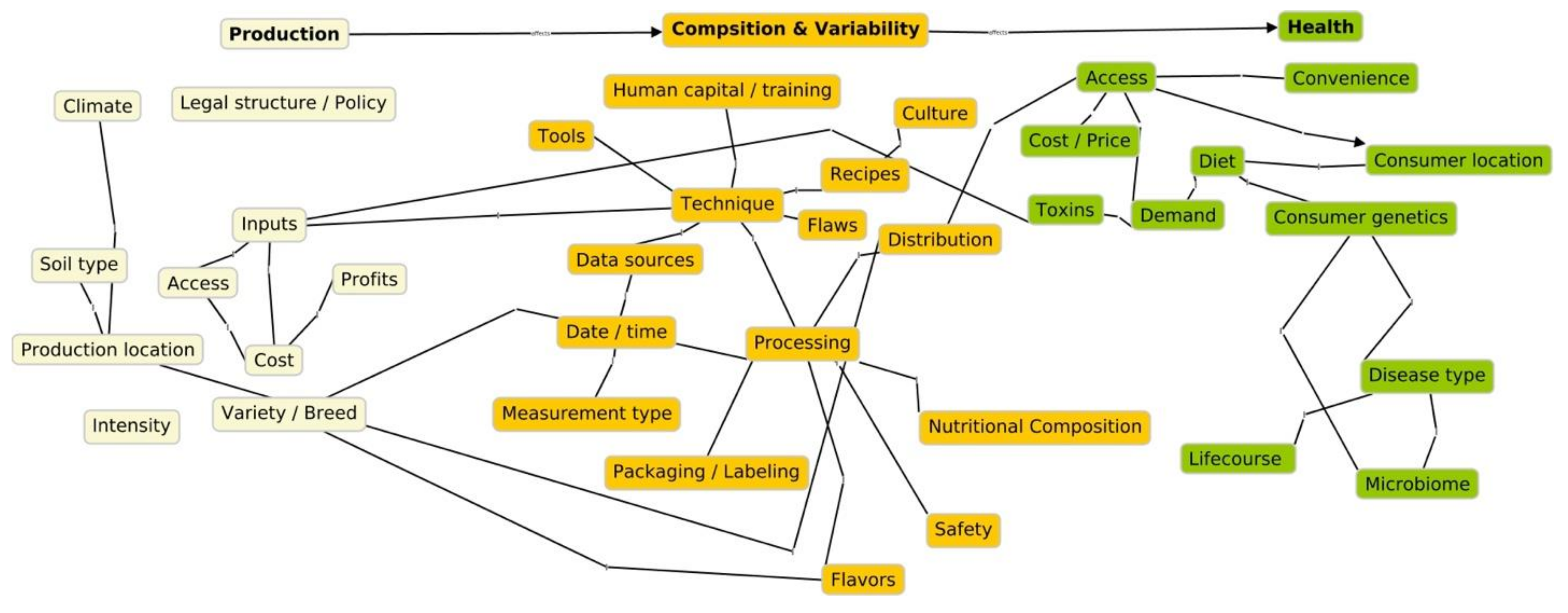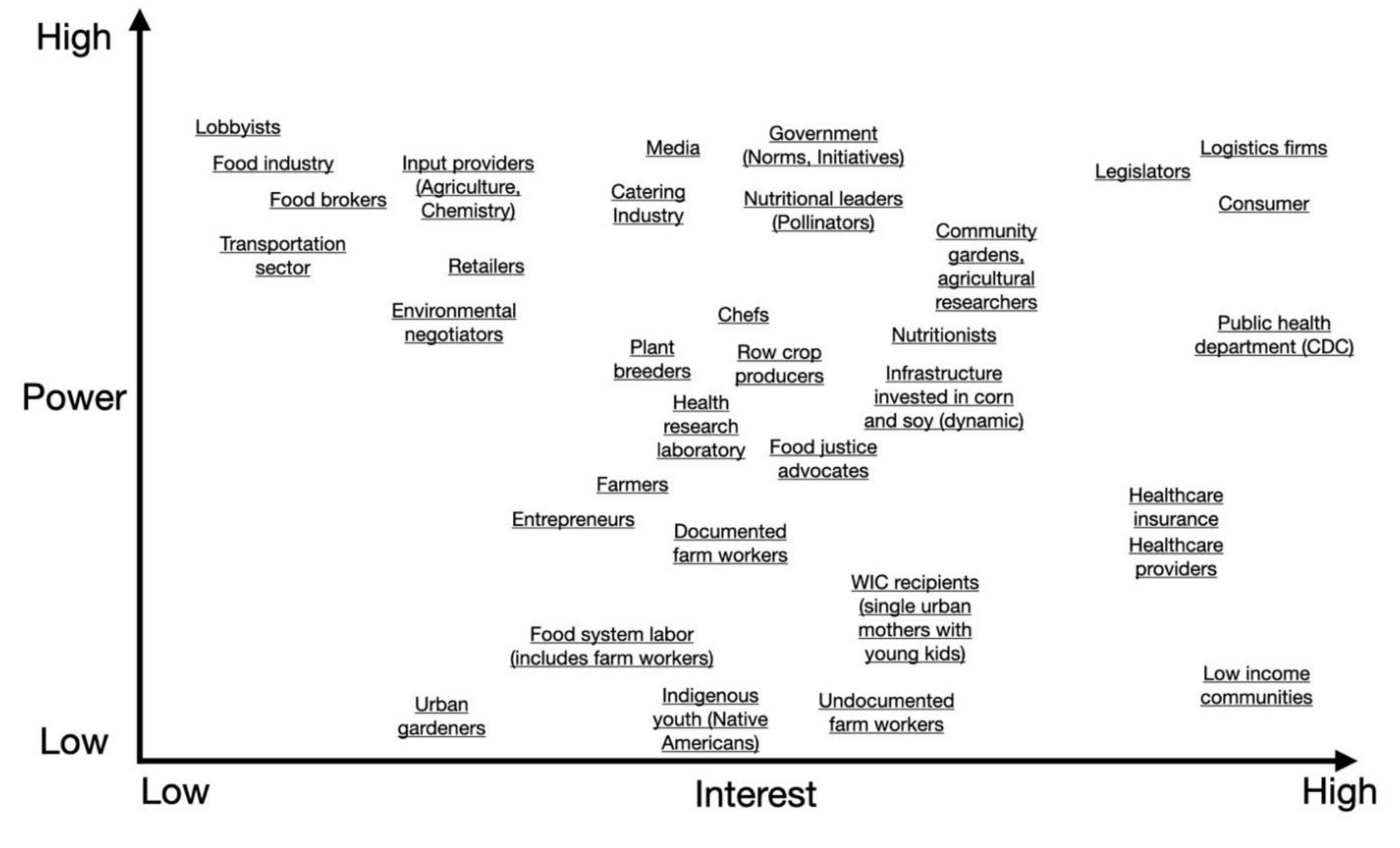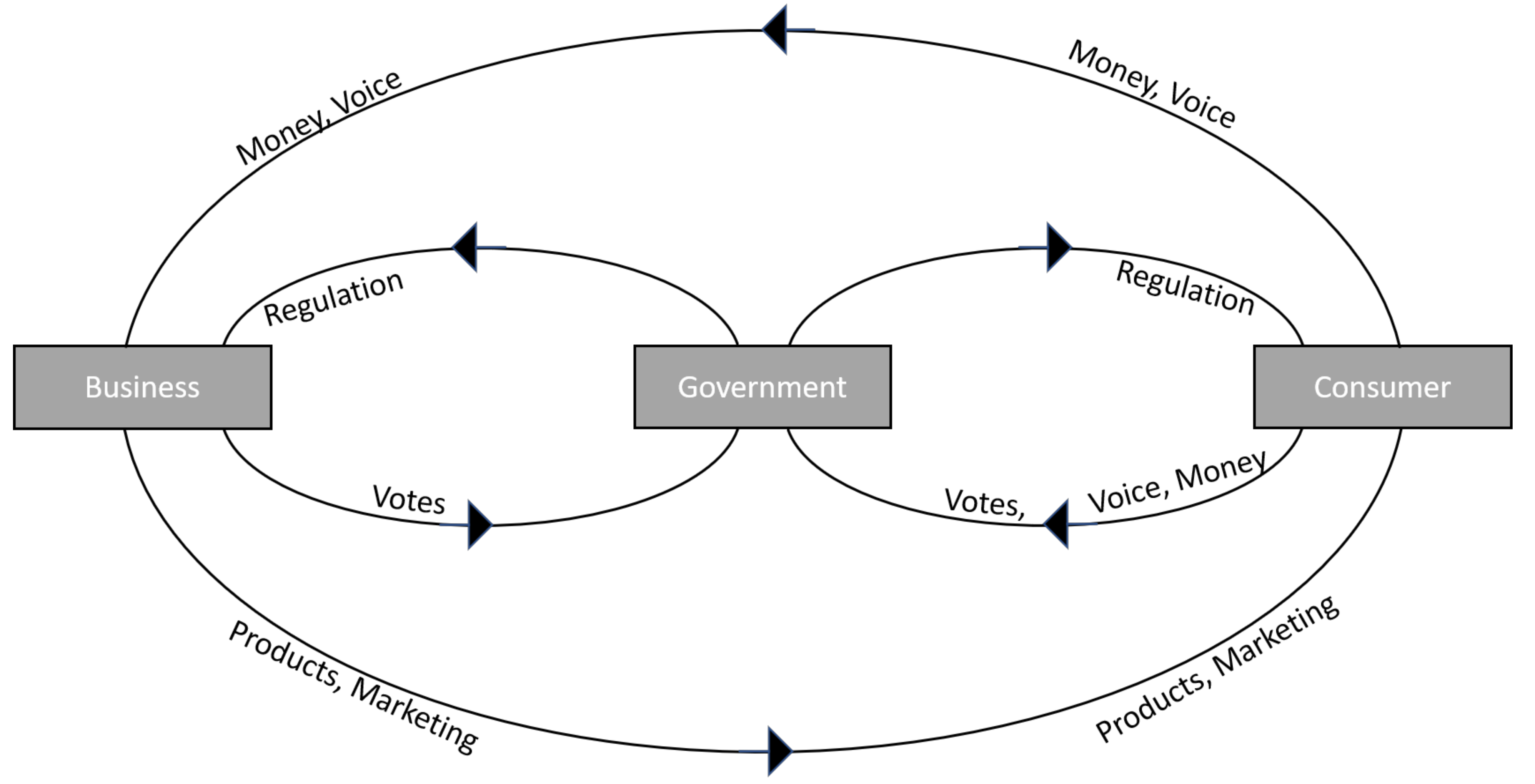Design and Implementation of a Workshop for Evaluation of the Role of Power in Shaping and Solving Challenges in a Smart Foodshed
Abstract
:1. Introduction
2. Materials and Methods
2.1. Setting
2.2. Workshop Participants
2.3. Workshop Organization
3. Results
4. Discussion
5. Conclusions
Supplementary Materials
Author Contributions
Funding
Institutional Review Board Statement
Informed Consent Statement
Data Availability Statement
Acknowledgments
Conflicts of Interest
References
- Hollander, A.D.; Hoy, C.; Huber, P.R.; Hyder, A.; Lange, M.C.; Latham, A.; Quinn, J.F.; Riggle, C.M.; Tomich, T.P. Toward Smart Foodsheds: Using Stakeholder Engagement to Improve Informatics Frameworks for Regional Food Systems. Ann. Am. Assoc. Geogr. 2020, 110, 535–546. [Google Scholar] [CrossRef]
- Dahlberg, K.A. Democratizing society and food systems: Or how do we transform modern structures of power? Agric. Hum. Values 2001, 18, 135–151. [Google Scholar] [CrossRef]
- Swinburn, B.; Egger, G.; Raza, F. Dissecting obesogenic environments: The development and application of a framework for identifying and prioritizing environmental interventions for obesity. Prev. Med. 1999, 29, 563–570. [Google Scholar] [CrossRef]
- Boyer, J. Food security, food sovereignty, and local challenges for transnational agrarian movements: The Honduras case. J. Peasant Stud. 2010, 37, 319–351. [Google Scholar] [CrossRef]
- Dekeyser, K. Land Investments, Food Systems Change and Democracy in Kenya and Mozambique. Politics Gov. 2019, 7, 12. [Google Scholar] [CrossRef] [Green Version]
- Wolf-Powers, L. Food Deserts and Real-Estate-Led Social Policy. Int. J. Urban. Reg. Res. 2017, 41, 414–425. [Google Scholar] [CrossRef]
- Pulker, C.E.; Trapp, G.S.A.; Scott, J.A.; Pollard, C.M. What are the position and power of supermarkets in the Australian food system, and the implications for public health? A systematic scoping review. Obes. Rev. 2018, 19, 198–218. [Google Scholar] [CrossRef]
- Swinburn, B. Power Dynamics in 21st-Century Food Systems. Nutrients 2019, 11, 2544. [Google Scholar] [CrossRef] [Green Version]
- Bedore, M. The convening power of food as growth machine politics: A study of food policymaking and partnership formation in Baltimore. Urban. Stud. 2014, 51, 2979–2995. [Google Scholar] [CrossRef]
- Jacobi, J.; Villavicencio Valdez, G.V.; Benabderrazik, K. Towards political ecologies of food. Nat. Food 2021, 2, 835–837. [Google Scholar] [CrossRef]
- Ostrom, E. Understanding Institutional Diversity; Princeton University Press: Princeton, NJ, USA, 2005; pp. 1–355. [Google Scholar]
- Steven, N.S.C. Private Property Rights and Sharecropping. J. Political Econ. 1968, 76, 1107–1122. [Google Scholar]
- Bowles, J.S. Making Tarefero Pride: The Collaborative Construction of Portable Photomurals for Farmworker Empowerment in Misiones, Argentina. J. Community Pract. 2018, 26, 392–411. [Google Scholar] [CrossRef]
- Rivera-Batiz, F.L. Undocumented workers in the labor market: An analysis of the earnings of legal and illegal Mexican immigrants in the United States. J. Popul. Econ. 1999, 12, 91–116. [Google Scholar] [CrossRef]
- Nguyen Khoa, S.; Smith, L.; Lorenzen, K. Adaptive, Participatory and Integrated Assessment (APIA) of the Impacts of Irrigation on Fisheries; IWMI Working Paper 89; International Water Management: Colombo, Sri Lanka, 2005. [Google Scholar]
- Reinhardt, J.; Liersch, S.; Abdeladhim, M.A.; Diallo, M.; Dickens, C.; Fournet, S.; Hattermann, F.F.; Kabaseke, C.; Muhumuza, M.; Mul, M.L.; et al. Systematic evaluation of scenario assessments supporting sustainable integrated natural resources management: Evidence from four case studies in Africa. Ecol. Soc. 2018, 23. [Google Scholar] [CrossRef] [Green Version]
- Lacy-Nichols, J.; Williams, O. “Part of the Solution:” Food Corporation Strategies for Regulatory Capture and Legitimacy. Int. J. Health Policy Manag. 2021. [Google Scholar] [CrossRef] [PubMed]
- Nestle, M. Food Politics: How the Food Industry Influences Nutrition and Health, Rev. and expanded ed.; University of California Press: Berkeley, CA, USA, 2007; 486p. [Google Scholar]
- Kaiser, M.L. Food Security: An Ecological–Social Analysis to Promote Social Development. J. Community Pract. 2011, 19, 62–79. [Google Scholar] [CrossRef]
- Lang, T. Reshaping the Food System for Ecological Public Health. J. Hunger Environ. Nutr. 2009, 4, 315–335. [Google Scholar] [CrossRef]
- Scutchfield, F.D.; Hall, L.; Ireson, C.L. The public and public health organizations: Issues for community engagement in public health. Health Policy 2006, 77, 76–85. [Google Scholar] [CrossRef]
- Leung, M.W.; Yen, I.H.; Minkler, M. Community-based participatory research: A promising approach for increasing epidemiology’s relevance in the 21st century. Int. J. Epidemiol. 2004, 33, 499–506. [Google Scholar] [CrossRef] [Green Version]
- Chaigneau, T.; Coulthard, S.; Daw, T.M.; Szaboova, L.; Camfield, L.; Chapin, F.S.; Gasper, D.; Gurney, G.G.; Hicks, C.C.; Ibrahim, M.; et al. Reconciling well-being and resilience for sustainable development. Nat. Sustain. 2021. [Google Scholar] [CrossRef]
- Yeatman, H.R. Food and nutrition policy at the local level: Key factors that influence the policy development process. Crit. Public Health 2003, 13, 125–138. [Google Scholar] [CrossRef]
- De Leeuw, E. Health policy, epidemiology and power: The interest web. Health Promot. Int. 1993, 8, 49–52. [Google Scholar] [CrossRef]
- El-Sayed, A.M.; Galea, S. Systems Science and Population Health; Oxford University Press: Oxford, UK; New York, NY, USA, 2017; 227p. [Google Scholar]
- Hammond, R.A. Complex systems modeling for obesity research. Prev. Chronic Dis. 2009, 6, A97. [Google Scholar]
- Luke, D.A.; Stamatakis, K.A. Systems science methods in public health: Dynamics, networks, and agents. Annu. Rev. Public Health 2012, 33, 357–376. [Google Scholar] [CrossRef] [PubMed] [Green Version]
- Hovmand, P.S. Community Based System Dynamics; Springer: New York, NY, USA, 2014; 104p. [Google Scholar]
- Langellier, B.A.; Kuhlberg, J.A.; Ballard, E.A.; Slesinski, S.C.; Stankov, I.; Gouveia, N.; Meisel, J.D.; Kroker-Lobos, M.F.; Sarmiento, O.L.; Caiaffa, W.T.; et al. Using community-based system dynamics modeling to understand the complex systems that influence health in cities: The SALURBAL study. Health Place 2019, 60, 102215. [Google Scholar] [CrossRef]
- Mui, Y.; Ballard, E.; Lopatin, E.; Thornton, R.L.J.; Pollack Porter, K.M.; Gittelsohn, J. A community-based system dynamics approach suggests solutions for improving healthy food access in a low-income urban environment. PLoS ONE 2019, 14, e0216985. [Google Scholar] [CrossRef] [PubMed]
- Swierad, E.; Huang, T.T.; Ballard, E.; Flórez, K.; Li, S. Developing a Socioculturally Nuanced Systems Model of Childhood Obesity in Manhattan’s Chinese American Community via Group Model Building. J. Obes. 2020, 2020, 4819143. [Google Scholar] [CrossRef]
- Hovmand, P.S.; Andersen, D.F.; Rouwette, E.; Richardson, G.P.; Rux, K.; Calhoun, A. Group Model-Building ‘Scripts’ as a Collaborative Planning Tool. Syst. Res. Behav. Sci. 2012, 29, 179–193. [Google Scholar] [CrossRef] [Green Version]
- Koh, K.; Reno, R.; Hyder, A. Designing an Agent-Based Model Using Group Model Building: Application to Food Insecurity Patterns in a U.S. Midwestern Metropolitan City. J. Urban. Health 2018, 95, 278–289. [Google Scholar] [CrossRef]
- Gerritsen, S.; Renker-Darby, A.; Harré, S.; Rees, D.; Raroa, D.A.; Eickstaedt, M.; Sushil, Z.; Allan, K.; Bartos, A.E.; Waterlander, W.E.; et al. Improving low fruit and vegetable intake in children: Findings from a system dynamics, community group model building study. PLoS ONE 2019, 14, e0221107. [Google Scholar] [CrossRef] [Green Version]
- Nelson, D.A.; Simenz, C.J.; O’Connor, S.P.; Greer, Y.D.; Bachrach, A.L.; Shields, T.; Fuller, B.A.; Horrigan, K.; Pritchard, K.; Springer, J.B.; et al. Using group model building to understand factors that influence childhood obesity in an urban environment. J. Public Health Manag. Pract. 2015, 21 (Suppl. S3), S74–S78. [Google Scholar] [CrossRef] [PubMed] [Green Version]
- Whelan, J.; Brown, A.D.; Coller, L.; Strugnell, C.; Allender, S.; Alston, L.; Hayward, J.; Brimblecombe, J.; Bell, C. The Impact of COVID-19 on Rural Food Supply and Demand in Australia: Utilising Group Model Building to Identify Retailer and Customer Perspectives. Nutrients 2021, 13, 417. [Google Scholar] [CrossRef] [PubMed]
- Waqa, G.; Moodie, M.; Snowdon, W.; Latu, C.; Coriakula, J.; Allender, S.; Bell, C. Exploring the dynamics of food-related policymaking processes and evidence use in Fiji using systems thinking. Health Res. Policy Syst. 2017, 15, 74. [Google Scholar] [CrossRef] [PubMed] [Green Version]
- Thomas, I.M.; Reilly, S.R. Group model building: A framework for organizing healthy community program and policy initiatives in Columbia, Missouri. J. Public Health Manag. Pract. 2015, 21 (Suppl. S3), S79–S83. [Google Scholar] [CrossRef]
- Star, S.L.; Griesemer, J.R. Institutional Ecology, ‘Translations’ and Boundary Objects: Amateurs and Professionals in Berkeley’s Museum of Vertebrate Zoology, 1907–1939. Soc. Stud. Sci. 1989, 19, 387–420. [Google Scholar] [CrossRef]
- Dooley, D.M.; Griffiths, E.J.; Gosal, G.S.; Buttigieg, P.L.; Hoehndorf, R.; Lange, M.C.; Schriml, L.M.; Brinkman, F.S.L.; Hsiao, W.W.L. FoodOn: A harmonized food ontology to increase global food traceability, quality control and data integration. NPJ Sci. Food 2018, 2, 23. [Google Scholar] [CrossRef]
- Hollander, A.D. PPOD Ontology. Available online: https://github.com/adhollander/ppod (accessed on 5 December 2021).
- Gordon, S.N.; Murphy, P.J.; Gallo, J.A.; Huber, P.; Hollander, A.; Edwards, A.; Jankowski, P. People, Projects, Organizations, and Products: Designing a Knowledge Graph to Support Multi-Stakeholder Environmental Planning and Design. ISPRS Int. J. Geo-Inf. 2021, 10, 823. [Google Scholar] [CrossRef]
- Allemang, D.; Hendler, J.; Gandon, F. Semantic Web for the Working Ontologist: Effective Modeling for Linked Data, RDFS, and OWL; Association for Computing Machinery: New York, NY, USA, 2020. [Google Scholar]
- Norris, E.; Hastings, J.; Marques, M.M.; Mutlu, A.N.F.; Zink, S.; Michie, S. Why and how to engage expert stakeholders in ontology development: Insights from social and behavioural sciences. J. Biomed. Semant. 2021, 12, 4. [Google Scholar] [CrossRef]
- IC-FOODS. IC-FOODS Conference. Available online: https://www.ic-foods.org/pastconferences/conference2019/conference (accessed on 15 March 2020).
- Andersen, D.F.; Richardson, G.P. Scripts for group model building. Syst. Dynam. Rev. 1997, 13, 107–129. [Google Scholar] [CrossRef]
- Hirschman, A.O. Exit, Voice, and Loyalty: Responses to Decline in Firms, Organizations, and States; Harvard University Press: Cambridge, MA, USA, 2004; 162p. [Google Scholar]
- Springer, N.P.; Garbach, K.; Guillozet, K.; Haden, V.R.; Hedao, P.; Hollander, A.D.; Huber, P.R.; Ingersoll, C.; Langner, M.; Lipari, G.; et al. Sustainable Sourcing of Global Agricultural Raw Materials: Assessing Gaps in Key Impact and Vulnerability Issues and Indicators. PLoS ONE 2015, 10, e0128752. [Google Scholar] [CrossRef] [Green Version]





| Business (Industry) * | Government/Regulators | Healthcare/Public Health | Business (Farmers) * | Consumers/Activists/Civil Society | Labor |
|---|---|---|---|---|---|
| Food industry | Lobbyists | Nutritional leaders (pollinators) | Row crop producers, infrastructure invested in corn + soy | Community gardens | Chefs |
| Food brokers | Legislators | Healthcare providers | Farmers | Agriculture researchers | Documented farm workers |
| Transportation sector | Environmental negotiators | Public health departments (CDC) | Plant breeders | Food justice activists | Undocumented farm workers |
| Input providers (e.g., Agriculture, chemical companies) | Government (norms, initiatives) | Health research laboratory | Urban gardeners | Low-income communities | Food system labor (includes farm workers) |
| Retailers | Healthcare insurance | WIC recipients (single, urban mothers with young kids) | |||
| Media | Nutritionists | Indigenous youth (Native Americans) | |||
| Catering industry | Consumer | ||||
| Logistics firms | |||||
| Entrepreneurs |
Publisher’s Note: MDPI stays neutral with regard to jurisdictional claims in published maps and institutional affiliations. |
© 2022 by the authors. Licensee MDPI, Basel, Switzerland. This article is an open access article distributed under the terms and conditions of the Creative Commons Attribution (CC BY) license (https://creativecommons.org/licenses/by/4.0/).
Share and Cite
Hyder, A.; Blatt, A.; Hollander, A.D.; Hoy, C.; Huber, P.R.; Lange, M.C.; Quinn, J.F.; Riggle, C.M.; Sloan, R.; Tomich, T.P. Design and Implementation of a Workshop for Evaluation of the Role of Power in Shaping and Solving Challenges in a Smart Foodshed. Sustainability 2022, 14, 2642. https://doi.org/10.3390/su14052642
Hyder A, Blatt A, Hollander AD, Hoy C, Huber PR, Lange MC, Quinn JF, Riggle CM, Sloan R, Tomich TP. Design and Implementation of a Workshop for Evaluation of the Role of Power in Shaping and Solving Challenges in a Smart Foodshed. Sustainability. 2022; 14(5):2642. https://doi.org/10.3390/su14052642
Chicago/Turabian StyleHyder, Ayaz, Angela Blatt, Allan D. Hollander, Casey Hoy, Patrick R. Huber, Matthew C. Lange, James F. Quinn, Courtney M. Riggle, Ruth Sloan, and Thomas P. Tomich. 2022. "Design and Implementation of a Workshop for Evaluation of the Role of Power in Shaping and Solving Challenges in a Smart Foodshed" Sustainability 14, no. 5: 2642. https://doi.org/10.3390/su14052642
APA StyleHyder, A., Blatt, A., Hollander, A. D., Hoy, C., Huber, P. R., Lange, M. C., Quinn, J. F., Riggle, C. M., Sloan, R., & Tomich, T. P. (2022). Design and Implementation of a Workshop for Evaluation of the Role of Power in Shaping and Solving Challenges in a Smart Foodshed. Sustainability, 14(5), 2642. https://doi.org/10.3390/su14052642









